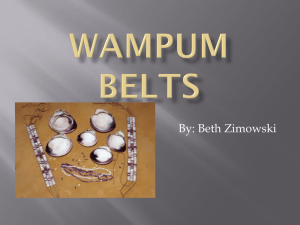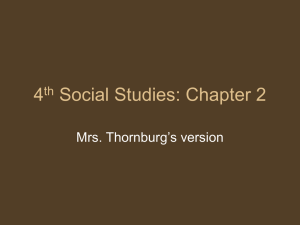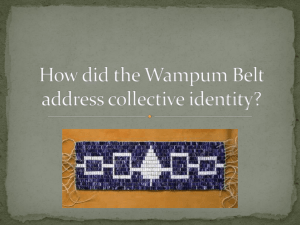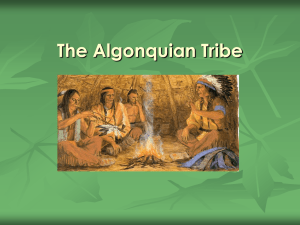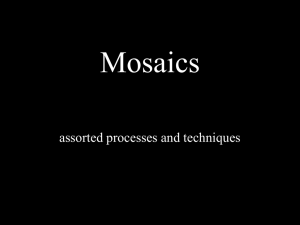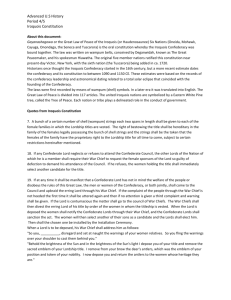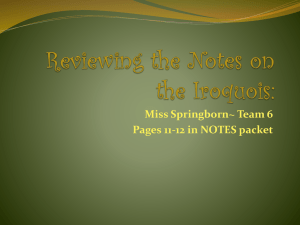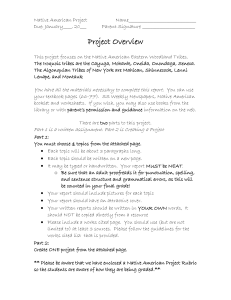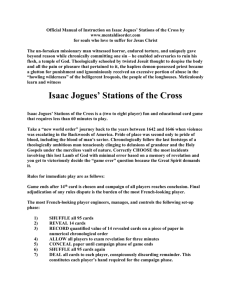Living as an Native American Indian
advertisement
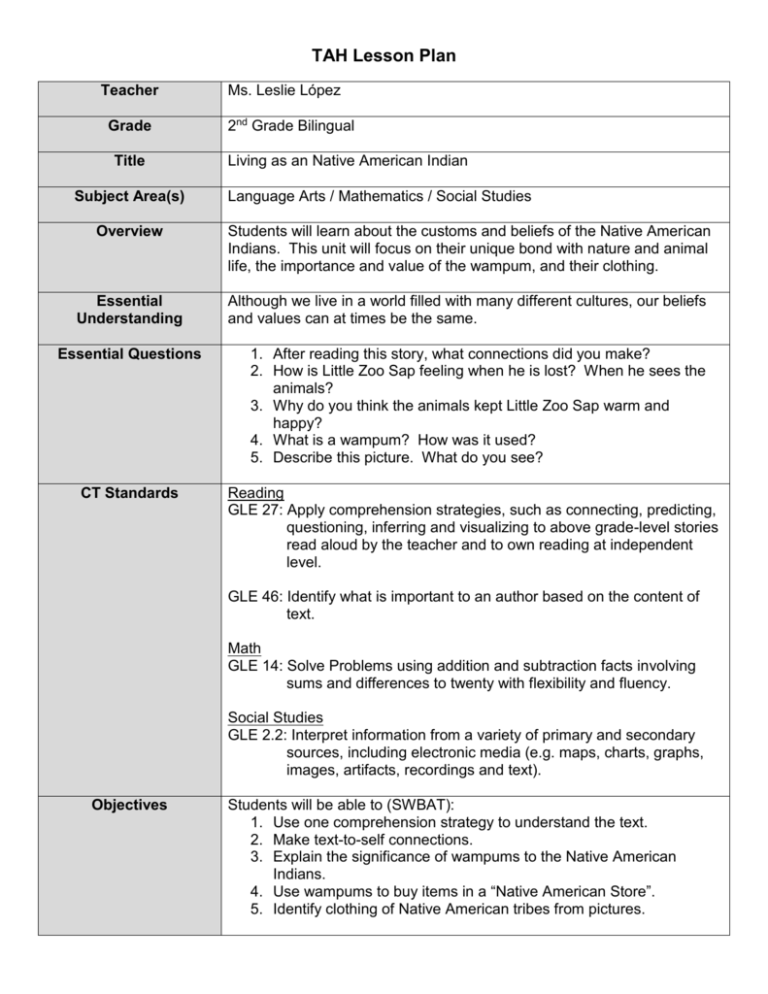
TAH Lesson Plan Teacher Grade Title Subject Area(s) Ms. Leslie López 2nd Grade Bilingual Living as an Native American Indian Language Arts / Mathematics / Social Studies Overview Students will learn about the customs and beliefs of the Native American Indians. This unit will focus on their unique bond with nature and animal life, the importance and value of the wampum, and their clothing. Essential Understanding Although we live in a world filled with many different cultures, our beliefs and values can at times be the same. Essential Questions CT Standards 1. After reading this story, what connections did you make? 2. How is Little Zoo Sap feeling when he is lost? When he sees the animals? 3. Why do you think the animals kept Little Zoo Sap warm and happy? 4. What is a wampum? How was it used? 5. Describe this picture. What do you see? Reading GLE 27: Apply comprehension strategies, such as connecting, predicting, questioning, inferring and visualizing to above grade-level stories read aloud by the teacher and to own reading at independent level. GLE 46: Identify what is important to an author based on the content of text. Math GLE 14: Solve Problems using addition and subtraction facts involving sums and differences to twenty with flexibility and fluency. Social Studies GLE 2.2: Interpret information from a variety of primary and secondary sources, including electronic media (e.g. maps, charts, graphs, images, artifacts, recordings and text). Objectives Students will be able to (SWBAT): 1. Use one comprehension strategy to understand the text. 2. Make text-to-self connections. 3. Explain the significance of wampums to the Native American Indians. 4. Use wampums to buy items in a “Native American Store”. 5. Identify clothing of Native American tribes from pictures. Materials Day 1 Thanks to the Animals 1. Thanks to the Animals by Allen Sockabasin 2. Chart paper 3. “Strategy Slip” worksheet 4. Writing journals 5. Wampum beads (both white and purple) 6. “Wampum Shopping” worksheet 7. Portraits of Native Americans 8. Projector to display images used by Native Americans. 9. Coloring paper 10. Crayons / Markers Details of the Activity Students will be asked to sit in a circle on the rug. The teacher will begin the lesson by discussing the goals and objectives of the unit and today’s lesson. Next, the teacher will ask the students to share what they already know about Native American living. Students will turn-and-talk with their neighbor to discuss their prior knowledge of this topic. In a whole group discussion, students will share their thoughts as the teacher records their responses on chart paper. The teacher will review all responses with the class. The teacher will then read Thanks to the Animals by Allen Sockabasin. Throughout the reading, the teacher will stop to ask those essential questions supporting the Native Americans’ belief and strong bond to the natural world. Students will be asked to return to their seats. The teacher will inform the class that they will need to select one of the six (6) comprehension strategies that helped them understand the story and where they used that strategy in the story. First, the teacher will model. The teacher will say, “One strategy I used today to help me understand this text was picturing. When I heard that Little Zoo Sap had fallen off the family sled, I pictured in my mind him falling into the snow and maybe getting hurt.” Working in pairs, each student will select one (1) strategy and write down where they used it in the text on the “Strategy Slip” worksheet. Once students have finished, the teacher will collect their worksheets and review all answers in a whole group discussion. To close the lesson, students will be asked to make a personal connection to the story and write it in their writing journals. The teacher will share with the students a Native American proverb which says: “Treat the earth well, it was not given to you by your ancestors, the earth was loaned to you by future generations.” Homework Day 2 Wampum Students will select another comprehension strategy that helped them understand the story and describe where in the story they used it. Details of the Activity Students will be asked to find a good listening spot on the rug. The teacher will begin the lesson by discussing the objectives for today’s lesson. The teacher will show the students a picture of a white wampum. The teacher will inform the students that the item they are looking at is called wampum. Next, the teacher will ask the students what they think the wampum was used in the Native American culture. Students will be given a minute to think and if necessary talk to their neighbor about their thoughts. The teacher will ask the students the students to share their responses with the entire class. The teacher will inform the students of the significance of the wampum so that the students understand its importance. Now, the teacher will present a purple wampum. The teacher will say, “Now that you know how the white wampum was used in the lives of the Native American Indians, what do you think the purple wampum represented?” Students will share their answers orally with the class. The teacher will share with the class a wampum bracelet from the Mashantucket Pequot Museum. Before students will get a chance to look at it, the teacher will review how important the wampum was and is to the Native American Indians. The teacher will say the following: “To Native people of the northeast, wampum is valued and respected. The giving of wampum symbolizes truth and integrity. The purple beads are used to remind us of the gravity of life and our responsibilities to the coming generations. The white beads represent the good mind and its love of peace and hope.“ Before the students are asked to take their seats, the teacher will inform the class that wampum were so valued to Native American Indians that they were also used as money. The purple wampum was worth double the value/cost of the white bead. Working at their seats, the students will be introduced to some of the items used by the Native Americans. The teacher will display these items on the projector. Next, the teacher will distribute the “Wampum Shopping” worksheet. The teacher will explain to the class that each student will be working with 5 purple wampum beads and 10 white wampum beads to buy some of the items on the sheet. Each student will have their chose of those items they would like to purchase. The teacher will model this exercise. In addition, the teacher will remind the students that the purple wampum beads are worth double than that of the white wampum bead. Each student will be working with 15 total wampum beads which is actually worth 20 wampum (5 purple = 10 wampum + 10 white wampum = 20 total wampum). Students will work on their worksheets and once completed, the class will review each student’s purchase. Homework Day 3 Clothing In their writing journals, students will write down one (1) thing they learned about the importance of the wampum. Details of the Activity Students will be asked to sit in a circle on the rug. The teacher will begin the lesson by discussing the objectives for today’s lesson. The teacher will ask the students, “Why do we wear clothes?” Student answers will vary. The teacher will explain to the students that the clothing worn by Native Americans not only was used to protect them, but also represented the tribe they belonged to, their connection to the natural world, and those things that were significant to the family and town. The teacher will inform the class that today they will be looking at various pictures of Native Americans and their clothing. The students will be asked to return to their seats. The teacher will display the images of Native American clothing on the projector. The teacher will go show and write the names of some of their clothing. Next, students will be given coloring paper to draw themselves wearing some of the Native American clothing learned in the lesson. Students will be given crayons to decorate their clothing. The teacher will leave the images on the board for the students to use as a reference. At the end of the lesson, students will come to the front of the class and describe what they are wearing in their picture. The teacher will collect all drawings and post them around the room. Homework Students will be asked to write in their writing journals about their drawing and describe why they would have worn the clothing they chose for themselves in their drawing. Suggested For this unit, the suggested assessment will be the “Strategy Slip” Assessment/Evaluation worksheet, the “Wampum Shopping” worksheet, and the drawing they made to include clothing worn by the Native Americans. Strategy Slip: Students will need to select one strategy that helped them understand the text and write specifically where in the text they used that strategy using complete sentences, proper punctuation, and capitalization. Wampum Shopping: Students will need to show how they were able to purchase the item by noting how many white and/or purple wampum they used to purchase that item. Drawing: Students will need to include at least 3 items learned about Native American clothing in their drawing. Rubric Strategy Slip Two (2) complete sentences with capital letters at the beginning and periods at the end. Details are included. One complete sentence with either a capital letter or period and some detail. Sentence fragment with no capital letter, no period, and no detail. Wampum Shopping I will need to look at each student’s work in order to evaluate their learning of the value of wampum and their problem solving (GLE 14). Drawing Three (3) Native American clothing items included in drawing. Two (2) Native American clothing items included in drawing. One (1) Native American clothing item included in drawing. Possible Extensions/Resources 1. Students can draw a picture to illustrate the comprehension strategy they used to help them understand the story (either from class or from homework). 2. Students will be given a “Wampum Shopping” worksheet to include additional items used by Native American Indians where students will work with 40 wampums (10 purple wampums + 20 white wampums). 3. Students label items worn by Native Americans in their drawings. 4. Read additional books about the importance of the natural world to Native Americans. 5. Watch a video of a Powwow demonstrating the various clothing worn by Native Americans. Name: ______________________________________________ Date: _______________________ One strategy I used today to help me understand this text is: (Circle one) Connecting Wondering Picturing Guessing Noticing Figuring out Here is a place in the text where I used this strategy: _____________________________________________________________________ Name: ______________________________________________ Date: _______________________ Wampum Shopping You have 10 white wampum and 5 purple wampum. What items can you buy? 7 wampum 3 wampum ____ white ____ white ____ purple ____ purple 5 wampum 4 wampum ____ white ____ white ____ purple ____ purple 12 wampum 8 wampum ____ white ____ white ____ purple ____ purple Pictures courtesy of 1, 2: http://www.google.com/imgres?imgurl=http://farm4.static.flickr.com/3076/3119120388_18950d486e.jpg&imgrefurl=http://w ww.flickr.com/photos/rawlife/3119120388/&usg=__rofCtE4mur5NZ0AUTgOFaBv269Y=&h=334&w=500&sz=158&hl=en&start=1&itbs=1&tbnid=bLt bGwD1gc63mM:&tbnh=87&tbnw=130&prev=/images%3Fq%3Dnative%2Bamerican%2Bchildren%26hl%3Den%26gbv%3 D2%26ndsp%3D21%26tbs%3Disch:1 3, 4: http://nativepeoplephotographer.typepad.com
